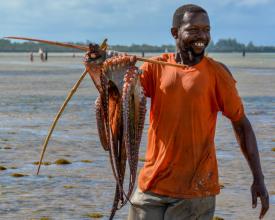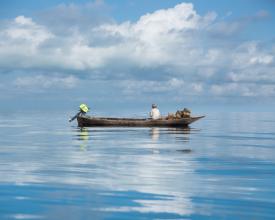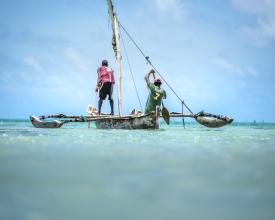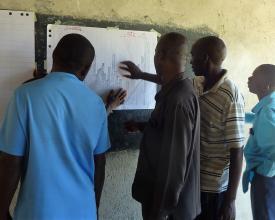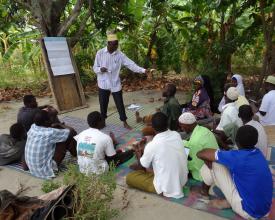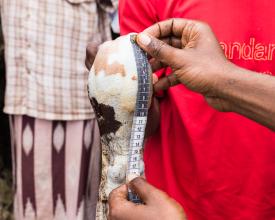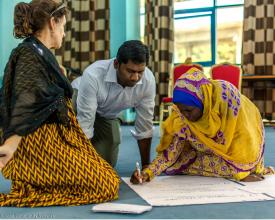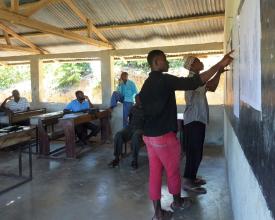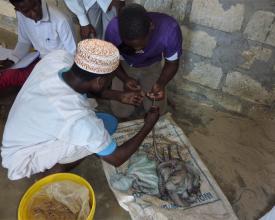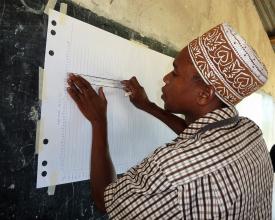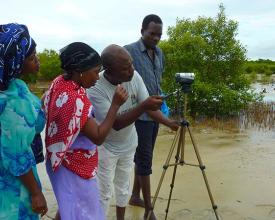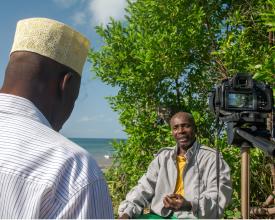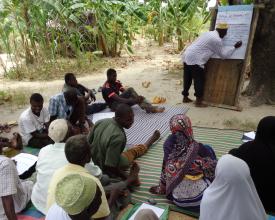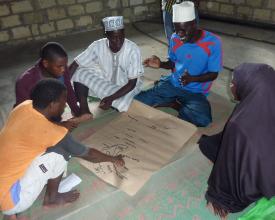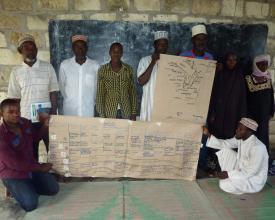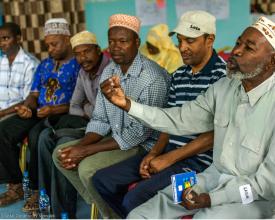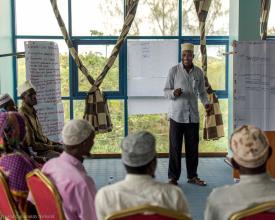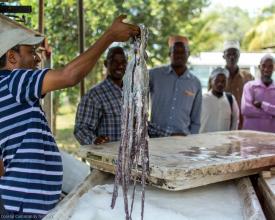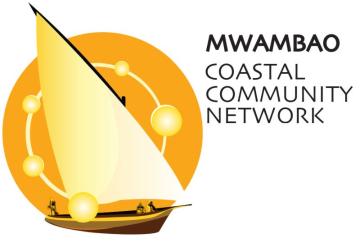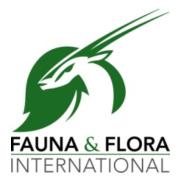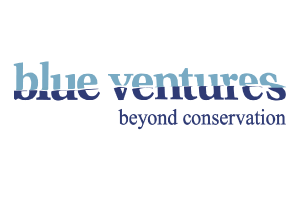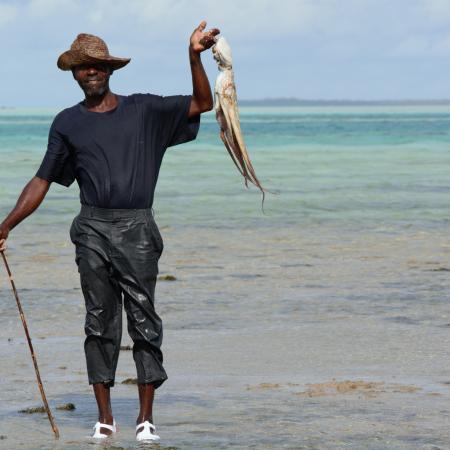
La gestion du poulpe - un point d'entrée pour la gestion collaborative de la pêche
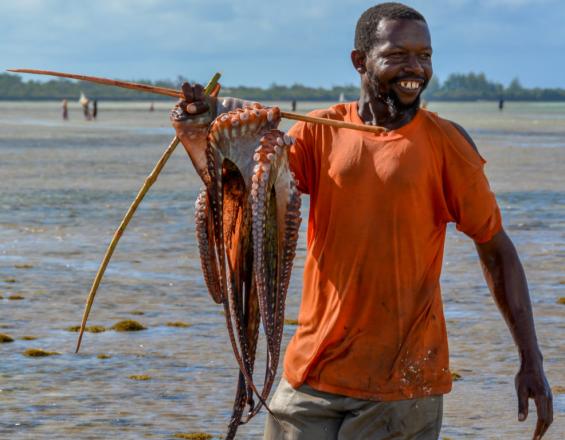
Cette solution concerne la gestion durable du milieu marin à Zanzibar face à une pression de pêche accrue. Elle montre que la mise en œuvre d'un régime efficace de gestion du poulpe peut améliorer les rendements en très peu de temps grâce à des zones d'interdiction de pêche volontaires de trois mois. L'approche participative de la formation, de l'apprentissage et de l'analyse des données peut constituer un point d'entrée pour l'introduction plus large d'une gestion collaborative, au bénéfice de toutes les parties prenantes.
Contexte
Défis à relever
Déclin des pêcheries et manque de capacité et d'expérience en matière de gestion concertée. Il y a peu de précédents de gestion collaborative dans les pêcheries de Zanzibar et une compréhension limitée des possibilités offertes par la législation actuelle. La pression démographique, les effets du changement climatique, le manque de moyens de subsistance alternatifs, la valeur ajoutée limitée, le remplacement des engins traditionnels par des engins plus efficaces, l'accès aux ressources et l'augmentation de la demande du marché pour l'exportation, augmentent la pression sur les ressources marines.
Emplacement
Traiter
Résumé du processus
- Discuter des principes de gestion du poulpe avec les pêcheurs et de la volonté d'une fermeture volontaire. Travailler avec le comité des pêcheurs du village (VFC) pour cartographier les zones de ressources en poulpe et identifier les emplacements potentiels des zones de non-prélèvement (NTZ), clarifier les procédures réglementaires et fournir une formation à la tenue des registres et aux patrouilles. Mener des actions de sensibilisation dans les villages voisins. Réaliser des entretiens d'analyse de la chaîne de valeur du poulpe avec les principales parties prenantes.
- BB1. Recrutement et formation d'enregistreurs et de collecteurs de données (au moins un mois avant la fermeture), début de la collecte des données.
- BB3. Fournir une formation complémentaire au comité sur les procédures opérationnelles standard.
- BB2. Après l'ouverture de la NTZ, organiser une formation à la vidéo participative et réaliser un court métrage avec le comité sur les leçons apprises (cette étape est facultative).
- BB1. Au moins 3 mois après l'ouverture, effectuer une analyse participative des données avec les enregistreurs et présenter les résultats au Département de la Pêche et à la communauté au sens large et discuter des implications pour la gestion.
- BB4. Réaliser une analyse de la chaîne de valeur pour d'autres pêcheries et la combiner avec une cartographie des ressources pour fixer des objectifs de conservation. Cela permettra d'identifier les besoins de recherche supplémentaires et de faciliter la planification de la gestion pour l'ensemble de la zone de pêche.
Blocs de construction
Collecte de données communautaires et analyse participative
Cet élément est lié à l'appropriation et à l'analyse in situ des données de surveillance collectées. Sur le site pilote, quatre villageois en fin de scolarité ont été recrutés et formés à l'enregistrement des données sur les captures de poulpes sur chacun des deux sites de débarquement. Une formation a été dispensée pour peser et mesurer les prises de 30 pêcheurs par jour pendant les 16 principaux jours de pêche du mois lunaire (marées de printemps). Les carnets de données ont ensuite été soumis chaque mois à l'enregistreur de données, un professeur d'école locale qui a été formé à l'utilisation d'Excel et d'un ordinateur portable. Les chefs de projet sont restés en contact régulier avec les enregistreurs de données et les résultats ont été vérifiés afin d'identifier les problèmes à un stade précoce. Après 8 mois d'enregistrement, deux paramètres ont été choisis pour examiner les résultats de l'exercice avec l'équipe d'enregistrement : la prise totale par période de pêche pour les deux sites de débarquement et la taille moyenne des poulpes par période de pêche. Les enregistreurs ont appris à faire des diagrammes à barres pour présenter les résultats. Une discussion détaillée avec les chefs de projet a permis d'explorer ce que les données et les tendances pouvaient suggérer. Les personnes chargées de l'enregistrement des données se sont ensuite rendues au siège du ministère du développement de la pêche et ont présenté leurs résultats. Une discussion s'en est suivie sur les implications pour la gestion et les changements suggérés.
Facteurs favorables
- Les membres de la communauté qui savent lire et écrire afin de pouvoir consigner par écrit les données relatives aux captures.
- Les acheteurs qui acceptent que leurs prises soient pesées et enregistrées sur le site de débarquement.
- Un membre de la communauté qui peut être formé à l'enregistrement des données sur un ordinateur portable.
- Un soutien régulier et de l'intérêt pour le travail des enregistreurs de données de la part des chefs de projet
- Un partenaire de soutien/chef de projet qui peut faciliter une analyse simple des données collectées de manière participative.
Leçon apprise
- Les personnes chargées de l'enregistrement des données doivent bien comprendre les données à collecter et l'importance d'un enregistrement correct. (Le nom et l'âge exacts des personnes, ainsi que le temps passé à pêcher sont importants pour que l'effort de pêche puisse être calculé, par exemple).
- L'enregistrement et la vérification réguliers des données sont essentiels pour que les erreurs ou les malentendus puissent être détectés rapidement et corrigés en conséquence (l'utilisation d'un formulaire de saisie restreint (macro) permet de minimiser les erreurs).
- L'analyse participative des données doit bénéficier d'un temps suffisant et être maintenue à un niveau facilement assimilable et présentable.
- L'analyse participative des données donne aux personnes chargées de l'enregistrement des données et au comité villageois des pêches la fierté et la confiance dans leur travail et leur permet de se faire mieux connaître des agents du département des pêches. Elle leur fournit également des preuves/références pour discuter des futures options de gestion avec la communauté.
Vidéo participative pour la documentation et le partage des leçons
La vidéo participative (PV) est utilisée pour explorer en profondeur la gestion du poulpe, documenter les succès, les défis ou les connaissances traditionnelles de la pêche au poulpe, et suivre les changements d'attitude, de connaissance ou de rendement au fil du temps. Les stagiaires, dont beaucoup n'ont jamais manipulé de matériel cinématographique, sont formés aux techniques de base ; - Les stagiaires décident du contenu du film et travaillent ensemble pour concevoir le story-board ; - Les stagiaires décident qui et où interviewer et tout le film est revu et discuté quotidiennement au retour ; - Le montage est limité dans le temps (2-3 jours) et est guidé par un "montage papier" effectué avec les stagiaires/membres de la communauté. Après avoir quitté le lieu de tournage, aucun montage ultérieur n'est effectué (à l'exception du sous-titrage), de sorte que le film reste tel qu'il a été revu par les stagiaires/les communautés villageoises. Le film qui en résulte est un produit visuel utilisé pour partager des leçons et des expériences sur la gestion du poulpe et qui s'appuie sur les traditions orales des communautés locales de pêcheurs dans un langage et une terminologie qui leur sont accessibles. L'objectif n'est pas de produire une cinématographie parfaite, mais de produire un produit communautaire et de communiquer les questions et les options de gestion du poulpe à un plus grand nombre de parties prenantes, y compris les nouveaux villages. Cette méthode n'a besoin d'être répétée que dans une ou deux communautés, mais elle est utile pendant la période de pilotage.
Facteurs favorables
- Disponibilité de l'équipement technique nécessaire à la réalisation et à la diffusion des films communautaires
- Disponibilité des stagiaires et des formateurs pour une période d'au moins 12 jours
- Engagement de l'équipe de stagiaires dans l'ensemble du processus
- Des animateurs formés au processus et aux techniques de tournage et de montage
- Des ressources financières pour couvrir le temps consacré par les participants
- Des conditions d'engagement claires et un consentement total pour le tournage.
- Consentement de tous les participants pour permettre à l'organisation et à la communauté d'utiliser librement le film sous sa forme actuelle.
Leçon apprise
- Le PV est un outil extrêmement puissant pour aller "sous la peau" d'un problème Le PV transmet de nombreuses compétences à la communauté
- Le PV renforce la confiance et la compréhension entre les animateurs et les stagiaires.
- Si possible, il est préférable que les stagiaires aient un accès à long terme à un équipement cinématographique simple ou à des smartphones pour une utilisation continue et l'enregistrement des leçons.
- Le PV nécessite une équipe d'animateurs engagés et compétents, mais il n'est pas nécessaire qu'ils soient des cinéastes ou des photographes qualifiés.
Ressources
Renforcement des capacités du comité des pêcheurs
La gestion collaborative explore les possibilités offertes par les réglementations et les lois actuelles en matière de pêche et permet d'améliorer la gestion des pêcheries de poulpe et d'autres espèces. Les défis résident à la fois dans le manque de capacité des comités de pêche villageois et dans la capacité du département de la pêche à transférer les responsabilités de gestion à ces comités. Les fonctionnaires sont souvent peu familiarisés avec les principes de la gestion collaborative et la manière dont elle peut améliorer la gestion des pêcheries au niveau local et aider le département à s'acquitter de ses responsabilités (par exemple, patrouilles, fermetures locales, etc.). Les chefs de projet ont impliqué les agents du département de la pêche dans toutes les formations des comités villageois de la pêche et ont assuré un retour d'information régulier au siège du département. Un manuel a été élaboré pour aider les agents du département et guider les comités de pêche villageois. Il comprend des sections sur : - Procédures opérationnelles standard pour les comités villageois de pêche - Mécanisme de gestion des conflits - Processus de formulation des règlements - Lignes directrices pour la tenue des registres - Stratégie d'autofinancement - Stratégie de communication
Facteurs favorables
- Modules de formation disponibles
- Soutien à l'ONG/au formateur avec les compétences et les ressources nécessaires
- Intérêt et volonté de la communauté
- Relations favorables avec les agents du ministère de la pêche
- Législation habilitante
- Manuel des procédures de fonctionnement des comités de pêche villageois rédigé dans la langue locale
Leçon apprise
- Lorsque la gestion collaborative de la pêche est nouvelle, il est impératif que les autorités de pêche ne se sentent pas menacées par le processus et qu'elles en comprennent pleinement les avantages. Il est donc important que les responsables de la pêche concernés participent à toute formation et que le personnel du siège du département soit tenu pleinement informé du processus.
- Il est important que les formations soient animées avec tact.
- Il est souhaitable que les comités villageois de pêche bénéficient d'un soutien et d'une formation continus pendant une période qui ne devrait pas être inférieure à deux ans, afin de renforcer leurs capacités et de les aider à relever les défis actuels.
- Lors de l'élaboration des règlements locaux, il est important que les amendes/pénalités proposées soient applicables.
- Les rôles et les responsabilités des membres du comité doivent être clairement compris afin de faciliter l'élection des personnes les plus appropriées aux postes clés.
- Les possibilités d'autofinancement des comités doivent être étudiées en collaboration avec les autorités chargées de la pêche, y compris les possibilités de collecte de revenus.
- Il est très important de renforcer les capacités de résolution des conflits, en particulier dans une pêcherie auparavant libre d'accès.
Analyse de la chaîne de valeur des principales pêcheries
Cela implique la collecte d'informations par le biais de groupes de discussion et d'entretiens avec les pêcheurs et les acheteurs afin de comprendre la pêche au poulpe, le nombre d'acheteurs, les prix, la transformation, la destination d'exportation et les critères de prise de décision, en particulier si un pêcheur est "enfermé" dans une relation avec un acheteur. Les entretiens utilisent les questions sur la chaîne de valeur incluses dans l'enquête STEP conçue par E. O'Neill du Stockholm Resilience Center. Des entretiens et des groupes de discussion ont été organisés avec des collecteurs et des acheteurs de poulpes, de concombres de mer et de cauris, ainsi qu'avec des producteurs d'algues. Des informations ont été recueillies sur les marchés d'exportation et les relations entre collecteurs et acheteurs. La chaîne d'approvisionnement du poulpe a été élaborée, les acteurs clés identifiés et les liens établis. La fluctuation des prix d'achat a été notée et les raisons en ont été étudiées. Ces informations sont précieuses pour concevoir une intervention visant à ajouter de la valeur à la pêcherie ou pour étudier la viabilité de nouveaux acheteurs ou de nouvelles destinations. Ce travail à Pemba a été suivi par des ateliers de "développement participatif du système de marché" (soutenus par FFI) avec toutes les parties prenantes. Tous les acteurs se sont ainsi engagés à jouer leur rôle dans le soutien de l'intervention, y compris les acheteurs qui ont accepté de négocier un prix fixe avec les comités de pêcheurs avant le "jour d'ouverture".
Facteurs favorables
- Confiance entre la personne interrogée et l'enquêteur permettant un partage ouvert de l'information
- Disponibilité du personnel du projet pour mener à bien les entretiens en collaboration avec les responsables de la pêche
- Disponibilité de ressources financières pour couvrir le temps de travail des personnes impliquées
- Informations préalables (c'est-à-dire évaluations des stocks si possible) sur la vulnérabilité des espèces pour une pêcherie particulière.
- Acheteurs favorables
Leçon apprise
- Certains marchés d'exportation se sont maintenus pendant de nombreuses années sans tenir compte de la demande à destination et de la possibilité d'ajouter de la valeur sur le lieu d'origine. Les possibilités de transformation et le potentiel de commercialisation doivent cependant être soigneusement évalués, par exemple en examinant la durabilité des niveaux actuels de récolte.
- Les facilités de crédit et la confiance semblent être les principaux facteurs qui incitent les pêcheurs à rester avec un acheteur particulier.
- Les principaux acheteurs ne sont pas aussi "irremplaçables" que supposé et des options de marché alternatives ont été révélées, ainsi que des options de transformation alternatives, par exemple le séchage du poulpe pour le transporter vers les marchés locaux lorsque les acheteurs d'exportation n'achètent pas (Pemba). Il est toutefois important d'entretenir des relations avec des acheteurs favorables dans la mesure du possible.
- Il n'y a apparemment pas d'incitation locale à pêcher des poulpes plus gros, bien que certains marchés d'exportation soient supposés payer un prix plus élevé pour ces individus.
Impacts
- Démonstration réussie de la capacité de gestion locale
- Démonstration réussie d'un régime de gestion efficace pour le poulpe
- Augmentation de la quantité et de la taille moyenne des poulpes au cours de la période du projet (début 2015 à aujourd'hui)
- Meilleure compréhension de la gouvernance locale et des réglementations de l'UCM (Unité de conservation marine) à la fois par le Comité des pêcheurs du village (VFC) et par les gestionnaires de la zone de conservation du canal de Pemba (PECCA).
- Compréhension du mécanisme d'établissement des règlements locaux
- Règlements en place
- Les étapes de la mise en place d'une gestion collaborative sont comprises et documentées dans un manuel.
- Capacité à collecter, enregistrer et analyser les données de base sur les captures au niveau local
- Capacité à documenter les expériences et les observations à l'aide d'une vidéo participative afin que les leçons puissent être partagées plus largement
- Volonté de la communauté de répéter la fermeture de la pêche au poulpe, mais aussi de commencer à explorer des régimes de gestion ciblés pour d'autres espèces telles que les concombres de mer, les cauris et les principales espèces de poissons.
- Une relation étroite s'est développée entre les autorités de l'unité de conservation marine et le comité de pêche du village local (VFC).
Bénéficiaires
Villages pilotes, comités de pêcheurs (VFC), gestionnaires de zones de conservation, acheteurs et consommateurs de produits de la mer, département du développement de la pêche, réseau de communautés côtières de MWAMBAO.
Objectifs de développement durable
Histoire

Les "banques" de pieuvres constituent une première étape passionnante vers la mise en place d'une gestion collaborative. Le poulpe de jour (Octopus cyanea) vit rarement plus de 24 mois. La femelle, qui ne se reproduit qu'une seule fois, pond, protège et aère ses œufs dans un profond repaire corallien pendant 30 jours. D'abord dispersés, les jeunes s'installent à nouveau sur le récif où ils grandissent rapidement, doublant leur taille en deux mois. La pêche au poulpe est un moyen de subsistance important à Zanzibar. En réalité, très peu d'habitants mangent du poulpe ; une grande partie des prises de Pemba est expédiée en Europe, tandis que les prises de l'île d'Unguja sont destinées aux hôtels touristiques locaux. En 2014, MWAMBAO Coastal Community Network a été contacté par le programme IOC-Smartfish, qui souhaitait piloter une gestion durable du poulpe, ainsi que par Fauna & Flora International, qui voulait promouvoir la cogestion dans la zone de conservation du canal de Pemba. Nous avons proposé de combiner les approches, en utilisant la gestion durable du poulpe comme point d'entrée pour une cogestion plus large. L'île pilote sélectionnée de Kisiwa Panza a vu les captures de poulpes diminuer. Les hommes et les femmes qui chassent le poulpe sur les récifs ont remplacé les bâtons traditionnels par des cannes en fer munies d'hameçons, et les hommes utilisent des masques et des palmes pour pêcher le poulpe dans les eaux plus profondes. Les villageois ont choisi une zone d'interdiction de pêche de 60 ha et les membres du comité des pêcheurs ont patrouillé dans la zone pendant trois mois. Nous avons formé des élèves en fin de scolarité à enregistrer les prises et recruté un enseignant pour enregistrer les données. Nous avons travaillé avec le comité et le personnel de PECCA pour créer des règlements et mener des campagnes de sensibilisation au niveau local. Les femmes ont suggéré de lever la fermeture pendant le mois coûteux du Ramadhan - en effet, la réserve serait une "banque" de poulpes. Seuls deux cas de braconnage ont été détectés et, le jour de l'ouverture, plus de 600 pêcheurs sont arrivés - une femme a attrapé un géant de 8 kg, ce qui est très rare. Huit mois de suivi ont montré qu'après l'ouverture, les prises ont augmenté de plus de 100 % ; quatre mois plus tard, les prises ne sont toujours pas retombées à leur niveau d'avant la fermeture et la taille moyenne des poulpes semble avoir augmenté. Les contrôleurs du village ont présenté leurs résultats au ministère de la pêche et le comité de pêche du village a enregistré leurs expériences à l'aide d'une vidéo participative. Les fermetures de la pêche au poulpe donnent des résultats rapides. D'après notre expérience, les avantages tangibles constatés le jour de l'ouverture renforcent la confiance entre le comité des pêches du village et les pêcheurs, ainsi qu'entre les responsables de la pêche et la communauté, ce qui ouvre la voie à d'autres négociations sur la cogestion.
